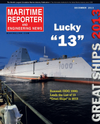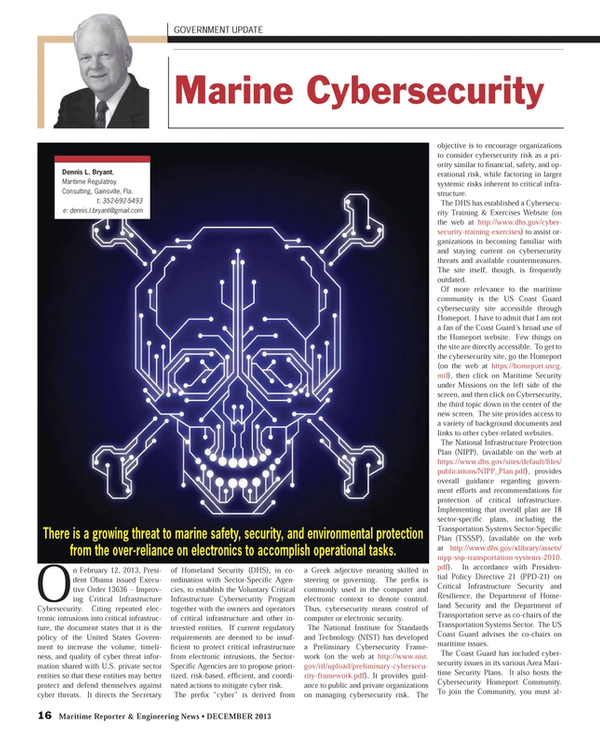
Marine Cybersecurity: Is Your Ship Safe? Are You Sure?
On February 12, 2013, President Obama issued Executive Order 13636 – Improving Critical Infrastructure Cybersecurity. Citing repeated electronic intrusions into critical infrastructure, the document states that it is the policy of the United States Government to increase the volume, timeliness, and quality of cyber threat information shared with U.S. private sector entities so that these entities may better protect and defend themselves against cyber threats. It directs the Secretary of Homeland Security (DHS), in coordination with Sector-Specific Agencies, to establish the Voluntary Critical Infrastructure Cybersecurity Program together with the owners and operators of critical infrastructure and other interested entities. If current regulatory requirements are deemed to be insufficient to protect critical infrastructure from electronic intrusions, the Sector-Specific Agencies are to propose prioritized, risk-based, efficient, and coordinated actions to mitigate cyber risk.
The prefix “cyber” is derived from a Greek adjective meaning skilled in steering or governing. The prefix is commonly used in the computer and electronic context to denote control. Thus, cybersecurity means control of computer or electronic security.
The National Institute for Standards and Technology (NIST) has developed a Preliminary Cybersecurity Framework (on the web at http://www.nist.gov/itl/upload/preliminary-cybersecurity-framework.pdf). It provides guidance to public and private organizations on managing cybersecurity risk. The objective is to encourage organizations to consider cybersecurity risk as a priority similar to financial, safety, and operational risk, while factoring in larger systemic risks inherent to critical infrastructure.
The DHS has established a Cybersecurity Training & Exercises Website (on the web at http://www.dhs.gov/cybersecurity-training-exercises) to assist organizations in becoming familiar with and staying current on cybersecurity threats and available countermeasures. The site itself, though, is frequently outdated.
Of more relevance to the maritime community is the US Coast Guard cybersecurity site accessible through Homeport. I have to admit that I am not a fan of the Coast Guard’s broad use of the Homeport website. Few things on the site are directly accessible. To get to the cybersecurity site, go the Homeport (on the web at https://homeport.uscg.mil), then click on Maritime Security under Missions on the left side of the screen, and then click on Cybersecurity, the third topic down in the center of the new screen. The site provides access to a variety of background documents and links to other cyber-related websites.
The National Infrastructure Protection Plan (NIPP), (available on the web at https://www.dhs.gov/sites/default/files/publications/NIPP_Plan.pdf), provides overall guidance regarding government efforts and recommendations for protection of critical infrastructure. Implementing that overall plan are 18 sector-specific plans, including the Transportation Systems Sector-Specific Plan (TSSSP), (available on the web at http://www.dhs.gov/xlibrary/assets/nipp-ssp-transportation-systems-2010.pdf). In accordance with Presidential Policy Directive 21 (PPD-21) on Critical Infrastructure Security and Resilience, the Department of Homeland Security and the Department of Transportation serve as co-chairs of the Transportation Systems Sector. The US Coast Guard advises the co-chairs on maritime issues.
The Coast Guard has included cybersecurity issues in its various Area Maritime Security Plans. It also hosts the Cybersecurity Homeport Community. To join the Community, you must already have a Homeport account. You then send an email to [email protected], asking to join. Members are provided with recommendations and activities helping them keep abreast of cybersecurity issues.
All of this may appear overwhelming to a ship owner or operator. After all, what is the likelihood that a terrorist will target your particular company or vessel or facility? Admittedly, the odds are low, but not zero. We know from the terrorist attacks of September 11, 2001, as well as the maritime attacks on the destroyer USS Cole in Aden on October 12, 2000, the supertanker Limburg off Yemen on October 6, 2002, and the supertanker M Star in the Strait of Hormuz on July 28, 2010, that terrorists seek soft targets. Marine facilities have not been exempt from terrorism, with attacks on Ashod, Israel (March 13, 2004); the Iraqi Khawr al Amaya crude oil terminal (April 24 2004); and the Karachi East Wharf in Pakistan (May 26, 2004). If your company or vessel or facility appears to be hardened, the terrorist will probably go elsewhere. There is plenty of evidence that the average maritime company or vessel or facility is vulnerable, particularly to a cyberattack.
Terrorism aside, there is a selfish reason for hardening your company, vessel, or facility against cyberattack. By taking such steps, you also may harden your operation against such threats as spurious electronic signals, malicious activity, industrial espionage, and criminal activities.
On May 10, 1993, the Coast Guard promulgated a regulation that came into effect on July 9, 1993 providing, among other things, that tankers equipped with an integrated navigation system (INS) could, under certain circumstances, use the INS with the auto pilot engaged while in the navigable waters of the United States. A suspension of the effectiveness of that regulation was issued on July 6, 1993 after a vessel utilizing its INS experienced a sudden, unintended, and drastic course change when the INS malfunctioned as a warship in the vicinity emitted a strong electromagnetic pulse. In its suspension order, the Coast Guard stated that currently (in 1993) “there is no performance standard for a shipboard INS in terms of accuracy, integrity, or reliability. Although the Coast Guard recognizes that the use of INS with an autopilot offers the potential to improve navigation safety, adequate testing and evaluation of this technology has not been conducted. The Coast Guard intends to conduct further rulemaking concerning necessary testing and methodology for certifying that performance standards have been met and will provide further opportunity for public input.” There have been no further developments regarding INS performance standards since 1993.
In the June 2003 edition of Maritime Reporter & Engineering News, I authored an article entitled: “AIS – Panacea or Pandora’s Box.” I pointed out that, when operating as intended, the Automatic Identification System (AIS) was an important navigational safety tool, particularly with respect to collision avoidance. I also pointed out, though, that because of the way the transceiver was configured, much of the data being transmitted could be manipulated. Specifically, I questioned reliance on AIS as a maritime security tool. I didn’t know the half of it. It has recently been demonstrated that spurious AIS signals can be transmitted showing vessels to be far from their actual location and on incorrect courses and speeds. AIS signals can also be generated showing phantom ships. One can no longer inherently trust the AIS signals being received by your transceiver and displayed on your ECDIS. The system needs to be revised to incorporate an authentication program.
In the September 2013 edition of this same magazine, I authored an article entitled: “GPS spoofing.” I pointed out that it is now possible to spoof Global Positioning System (GPS) and other space-based positioning, navigation, and timing (PNT) services. As with AIS, these PNT services must incorporate an authentication system or adopt other measures to avoid accidental or intentional presentation of erroneous data. Work is currently underway to address these issues. Even then, it will likely only make spoofing more difficult, but not impossible.
I do not claim to be prescient. I am only reporting the work of others, more technologically proficient than myself. I am saying, though, that steps should be taken by members of the maritime community to enhance their cybersecurity. There is a growing threat to marine safety, security, and environmental protection from the over-reliance on electronics to accomplish operational tasks. Adopting appropriate cybersecurity measures will reduce business risks.
(As published in the December2013 edition of Maritime Reporter & Engineering News - www.marinelink.com)
Read Marine Cybersecurity: Is Your Ship Safe? Are You Sure? in Pdf, Flash or Html5 edition of December 2013 Maritime Reporter
Other stories from December 2013 issue
Content
- Coming your way, a 3% rise in Operating Costs page: 10
- Five Minutes With: Tore Morten Olsen, Astrium Services page: 12
- Marine Cybersecurity: Is Your Ship Safe? Are You Sure? page: 16
- U.S. Export Reform: New Year, New Rules page: 18
- U.S. Port Security and the Impact of Sequester & Budget Woes page: 20
- Global Port Security and BMT Isis page: 22
- LED Lighting: Reduced Costs, Enhanced Safety page: 24
- India's Maritime Growth Fueled by Foreign Companies page: 26
- New Crane from Liebherr for Harbors, Offshore page: 28
- Ship Power: Out of the Past Comes Wärtsilä's Engine of the Future page: 30
- The Navy’s Battlewagon of the 21st Century page: 34
- Maersk’s Mammoth Containerships Making History page: 40
- New Bulk Carrier from Imabari Offers Unique Advantages page: 42
- Damen PSV 3300: A Diamond in the Rough page: 43
- Bourbon and CGG Partner for Seismic Survey Success page: 44
- Great Ships of 2013: Shuttle Tanker RIO 2016 for TEN page: 45
- Great Ships of 2013: Bow Pioneer page: 46
- Great Ships of 2013: Hornbeck’s HOSMAX 300 Series page: 47
- Great Ships of 2013: Oceanex Connaigra page: 48
- Great Ships of 2013: Hydra Voyager page: 48
- Great Ships of 2013: Damen Modular Barge page: 49
- What’s New with Floating Production? page: 50
- New Monitoring System from Rexroth page: 56
- Regal Motors Win Russian OK page: 56
- Jotun Debuts New Eco Antifouling page: 56
- New “Energy Demand Forecast System for Ships” page: 56
- Ultra Steam Turbine Plants page: 56
- Delta Plasma Rotator Launched page: 56
- LaBorde Launches New Compact Power Unit page: 56
- MTU Gensets for British Combat Ship page: 57
- Product Spotlight: Viking LifeCraft Evacuation System page: 57
- Sherwin-Williams Launch Marine Coatings App page: 57
- SMT Develops Robotic Tube Cutter page: 57
- Optimarin Inks Ballast Water Treatment Deal with V.Ships page: 57
- SturdiLED LED Floodlight Released page: 57
- IHC Debuts “Zero-Pollution” Seal page: 57


